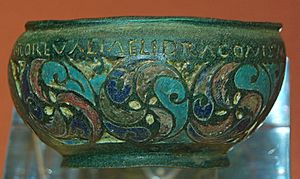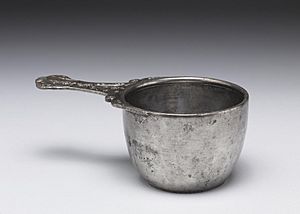Staffordshire Moorlands Pan facts for kids
The Staffordshire Moorlands Pan, also called the Ilam Pan, is a small bronze pan from the 2nd century AD. It's special because it has colourful enamel decoration and an inscription (writing) that names four forts along Hadrian's Wall. The pan is made of bronze and decorated with vitreous enamel, which is like a type of coloured glass melted onto metal. This kind of decoration was very popular in ancient Celtic art. The pan's designs are a rare link between older Iron Age art and later "Celtic" art from the Early Medieval period.
This pan weighs about 132.5 grams. It is 47 millimetres high and about 94 millimetres wide. Some people think that besides being used for cooking or serving food, it might have been a souvenir. Perhaps a Roman soldier who served on Hadrian's Wall bought it as a keepsake. It might have been made as a plain decorative pan first, and then the special writing was added later.
The pan was found in June 2003 by people using metal-detectors in a place called Ilam, Staffordshire, which is far south of Hadrian's Wall. In 2005, three museums bought it together: the Tullie House Museum in Carlisle, the Potteries Museum in Stoke-on-Trent, and the British Museum in London. They got help from a grant of £112,200 from the Heritage Lottery Fund. This pan is very important for understanding history in Britain and around the world. It travels between the museums that own it and other museums near Hadrian's Wall.
What the Pan Looks Like
The Staffordshire Moorlands Pan is a very well-preserved bronze vessel. It was used for cooking and serving food. Even though it's missing its handle and base, its colourful enamel decoration is still amazing. The pan is decorated in a Celtic style. People from the Celtic cultures during the Roman period used enamel on metal more than other parts of the Roman Empire.
Its Unique Decoration
The pan's decoration has eight round shapes. Between these round shapes are eight pairs of triangle-like designs. Each round shape has a swirling, six-armed pattern. In the middle of each swirl is a three-petalled flower design. These designs are filled with bright red, blue, turquoise, and yellow enamel.
The Special Inscription
Around the rim of the pan, there is writing carved into the metal and then filled with enamel. This writing names four forts along Hadrian's Wall:
- MAIS (which is now Bowness-on-Solway)
- COGGABATA (now Drumburgh)
- VXELODVNVM (now Stanwix)
- CAMMOGLANNA (now Castlesteads)
The last part of the inscription says: RIGORE VALI AELI DRACONIS. This part is a bit harder to understand fully. However, "VALI" clearly refers to the wall itself. "DRACO" probably refers to a soldier named Draco. "AELI" might be part of his name, or it could refer to Hadrian, the Roman emperor who built the wall. Hadrian's family name was Aelius, so "AELI" might mean "Aelian Wall," which is what the Romans might have called it.
Other Similar Pans
There are other similar Roman pans, called trullae, that have been found. Two of these also have writing about Hadrian's Wall. The writing on the Staffordshire Moorlands Pan suggests it was probably made close to where it was found in Britain. Based on other finds, the pan's handle would have been flat and also decorated with enamel. The Rudge Cup is another famous Roman object with names of forts on Hadrian's Wall.



